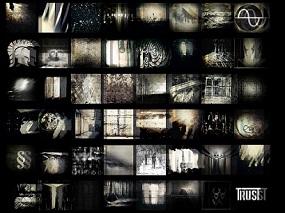The Things Our Ancestors Gave Us – Part 1
When most of us think of the words “ancestor” and “music” in the same context, there is no doubt in my mind that a plethora of names may emerge. I certainly know it happens to me. Maybe Robert Hood pops into view. Perhaps Jeff Mills and the UR enter. One could easily argue that the Belleville Three are influential.
Who could forget where it all seems to start with four strange Germans who call themselves Kraftwerk? Hardly anyone, I’m sure…
Many of us are strikingly opinionated about electronic music. We often feel very strongly about the reasons for listening to a certain style, who is better than who in this or that genre, what a specific type of music should be called, what we buy, what we try to emulate, et cetera. All this happens, of course, while the top producer/DJs are likely laughing their asses off at all the bickering and nonsense occurring amongst the 99%.
There is hardly room to argue that the two individuals I will examine here are considered among the best: musicians who were able to define how music operates as a language while exploring the concepts of rhythm, motives, harmony, melody, contrast, musical space, and emotion (to name a few), all combined in a way that satisfies their strict musical demands. For anyone interested, they provide a musical compendium of guidelines regarding the grammatical and structural process of music making. If you know where to look, that is…
By now you’re probably reeling in excitement at the prospect of my mentioning the name of your favorite artist of the 1970s or 1980s as my subject matter. After all, what would an entertaining and informative article be if it hadn’t some “hype” to pull you in? I’m afraid I’m going to ruin your day a bit, because the ancestors I’ve been talking about aren’t even in the realm of electronic music. They weren’t even operating in the same century as all this electronic innovation that interests us so much was happening. In fact, one of the persons in question was born in 1756, and the other was Deaf.
Now, before you click the back button, please realize that by considering a few of the simple concepts within the musical examples I have carefully selected to prove my point, your musical productions will improve. Imagine how efficiently and effortlessly the musical ideals encoded in the works of Mozart and Beethoven (Yes, that’s the famous duo I’ll be discussing) may transfer from the depths of your conscious mind, though your DAW, and out your monitors to the delight of DJs everywhere! Shall we proceed? If you’ve made it thus far, I’m assuming I’ve succeeded in retaining your interest, so let’s go…
One of the most interesting things I’ve learned in the last 30 years as a classically trained pianist is that the simplest music is the most difficult to create. Why is this so? By assessing many works of music from all genres, and after digging for that one clue that helps serve as a basis for my own personal understanding of the art, I’ve discovered that the difficulty lies within the discomfort many of us feel with being “exposed,” so to speak. Here’s what I mean:
Take the MIDI clip I have created and load it into your DAW so it can be viewed easily.
MIDI CLIP: Right click & Save as
For a more authentic experience, load up an acoustic piano and listen to the piece for a few moments. For the most authentic experience, load a harpsichord! After listening for a few moments, I’m sure you may find this work quite familiar. Sure, it’s quite dated as far as style goes. Most of the readers may associate such music with sophisticated old-timers whose only worry every day is what they are having for lunch. However, there is an amazing concept happening here that many of you might find interesting; something immediately applicable to your own modern productions. Something Mozart understands spot-on. Notice that throughout a great majority of the piece, there are rarely more than two notes being played at the same time.
Sure, there are places where chords occur and there are notes being held to provide “filler” while others meander, but if you quantize all notes to the nearest 16th and briefly survey the field, you will quickly find that rarely will there be more than two notes initiated simultaneously. This fascinates me, especially considering the incredible amount of music Mozart is able to generate from a seemingly minimal amount of material. Talk about being exposed! This is why pianists fear Mozart on stage. It is so thin in its texture, so exposed in its skeletal appearance, that any musical or physical misjudgment is immediately apparent to the audience. Mistakes really sound like mistakes…
This is often what keeps many of us from achieving a fluid workflow in the studio. We stop to question our own creations, inventions, and perhaps our most cherished contributions- our ideas. We tend to add more and more elements into the mix to subconsciously cover up what we immediately feel is “not enough.” We become distracted by the literally endless possibilities music has to offer. The reason? Those elements, sounds, and ideas come from within us, and leaving ourselves open to judgment invites all kinds of opinion, both good and bad. That usually scares us. Fortunately, most people are very supportive of others, regardless of their skill level. But as a stage performer, I always tend to care more about the one guy who didn’t like the show…
Apologies for diverting a bit, but I strongly believe that keeping things simple, focusing your attention, and concentrating on one or two elements in your music will help you develop a sense of personal style with regards to sounds, structure and texture. It is extremely difficult to do. So how can we achieve this effectively? Let’s take a closer look at what Mozart seems to do so effortlessly. When we take a “big picture” look at this example, we clearly see that there are two independent lines working to produce this texture. There is a melodic line in the right hand, and a repetitive pattern in the left hand that acts more as a supporting element. It truly couldn’t be simpler. Say we concentrate our effort on the first couple of bars and decode what is really happening here, and more importantly, how it relates to our modern methods. I think we will find something worthwhile. Check out this video for a more engaging experience:
[youtube http://www.youtube.com/watch?v=UDSb_I2rvp8]
Now please understand that the original music being generated here is due to the composer’s understanding of things that most electronic musicians eschew for more interesting and modern musical elements. For example, the music Mozart is making is heavily based on melodic linearity that spins itself out in a way that keeps the listener actively engaged. He is also using harmonic language in a way that supports the melody on both local and large-scale levels. (More on this later when we take a look at structure.) He doesn’t have filters, delays, or back-masking to make his sound varied. He’s not interested in how sub-basses, side-chaining, and EQ works to create that perfect mix. He’s simply using basic musical tools to ensure that the linear movement forward in time happens in a sensible, entertaining manner.
This is very similar to the quest we all make to find that “sound.” The sound of which I speak includes cool bass lines, fat kicks, penetrating leads, velvety pads, heavy distortion, whatever your heart and ear desires… But the concentration usually focuses on things like sound design, fidelity, special effects, et cetera. How a short melody changes over a long period of time is often considered structurally important. The chords one includes may be critical, at one point or another, to the overall listening experience. In other words, what Mozart uses to retain interest (like melodic and harmonic progression), are replaced by quirky, unique sounds, repetition, and technological sound-altering effects. But my point is that what Mozart is using is extremely limited. He makes up for the lack of texture by ensuring that the melodic material and harmonic support, all encased within catchy rhythms and directional contours, are arranged in a manner that expresses and communicates the language effectively.
For us, it’s the other way around. We are often not concerned with extravagant melodic content and a harmonic language that requires years of theoretical study. Therefore, we concentrate more on how effects and technology can create long-term interest with very basic melodic and harmonic material, or in the case of some techno, the quality of sounds being used. But the end result is the same: The most effective music is that which utilizes the least amount of material.
So far, we have a bass line. In the next installment, we will look to the concept of “motive” in a work of Beethoven and see what we can learn from him regarding melodic interest. Stay tuned!



sam
May 07. 2012
Thanks Jamie, really good read. Looking forward to the next installment.
Patriek
May 07. 2012
Nice read and video Jamie. Enjoyed listening/reading and watching it.
ICN
May 07. 2012
Top stuff Jamie!! : )
Mslwte
May 07. 2012
Well done and thank you Jamie 🙂